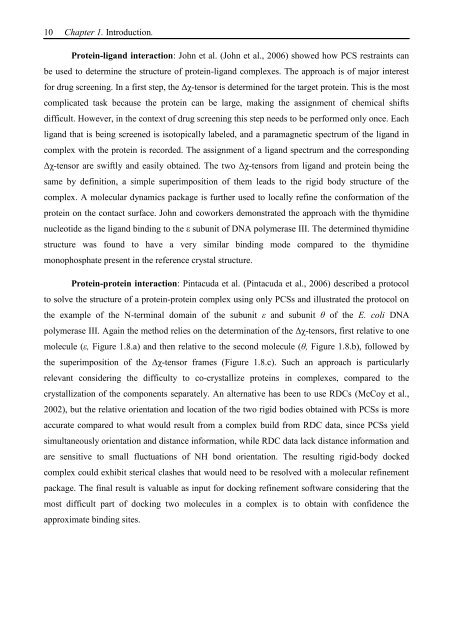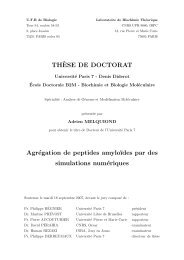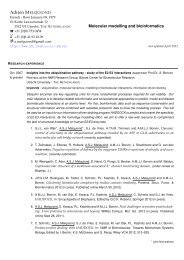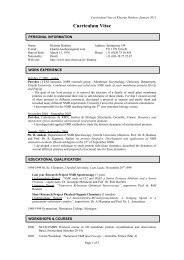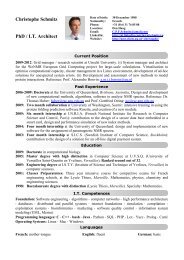Thesis Title: Subtitle - NMR Spectroscopy Research Group
Thesis Title: Subtitle - NMR Spectroscopy Research Group
Thesis Title: Subtitle - NMR Spectroscopy Research Group
Create successful ePaper yourself
Turn your PDF publications into a flip-book with our unique Google optimized e-Paper software.
10 Chapter 1. Introduction.<br />
Protein-ligand interaction: John et al. (John et al., 2006) showed how PCS restraints can<br />
be used to determine the structure of protein-ligand complexes. The approach is of major interest<br />
for drug screening. In a first step, the Δχ-tensor is determined for the target protein. This is the most<br />
complicated task because the protein can be large, making the assignment of chemical shifts<br />
difficult. However, in the context of drug screening this step needs to be performed only once. Each<br />
ligand that is being screened is isotopically labeled, and a paramagnetic spectrum of the ligand in<br />
complex with the protein is recorded. The assignment of a ligand spectrum and the corresponding<br />
Δχ-tensor are swiftly and easily obtained. The two Δχ-tensors from ligand and protein being the<br />
same by definition, a simple superimposition of them leads to the rigid body structure of the<br />
complex. A molecular dynamics package is further used to locally refine the conformation of the<br />
protein on the contact surface. John and coworkers demonstrated the approach with the thymidine<br />
nucleotide as the ligand binding to the ε subunit of DNA polymerase III. The determined thymidine<br />
structure was found to have a very similar binding mode compared to the thymidine<br />
monophosphate present in the reference crystal structure.<br />
Protein-protein interaction: Pintacuda et al. (Pintacuda et al., 2006) described a protocol<br />
to solve the structure of a protein-protein complex using only PCSs and illustrated the protocol on<br />
the example of the N-terminal domain of the subunit ε and subunit θ of the E. coli DNA<br />
polymerase III. Again the method relies on the determination of the Δχ-tensors, first relative to one<br />
molecule (ε, Figure 1.8.a) and then relative to the second molecule (θ, Figure 1.8.b), followed by<br />
the superimposition of the Δχ-tensor frames (Figure 1.8.c). Such an approach is particularly<br />
relevant considering the difficulty to co-crystallize proteins in complexes, compared to the<br />
crystallization of the components separately. An alternative has been to use RDCs (McCoy et al.,<br />
2002), but the relative orientation and location of the two rigid bodies obtained with PCSs is more<br />
accurate compared to what would result from a complex build from RDC data, since PCSs yield<br />
simultaneously orientation and distance information, while RDC data lack distance information and<br />
are sensitive to small fluctuations of NH bond orientation. The resulting rigid-body docked<br />
complex could exhibit sterical clashes that would need to be resolved with a molecular refinement<br />
package. The final result is valuable as input for docking refinement software considering that the<br />
most difficult part of docking two molecules in a complex is to obtain with confidence the<br />
approximate binding sites.


